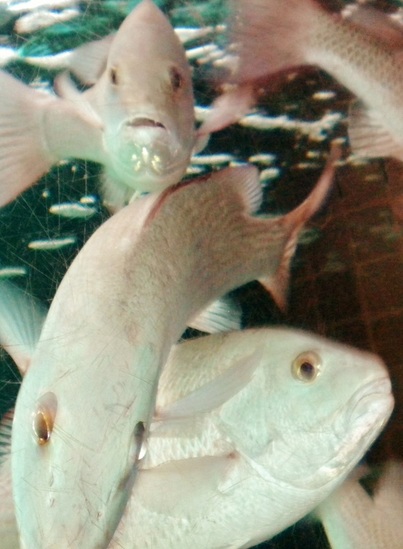Mangrove (or gray) snappers
The mangrove snappers at Gulf Shore Aquarium live in the Florida Fishes tank with Fred and Barney, the nurse sharks. The snappers like to mug for guest photos and school around the viewing windows. What follows is a primer of other facts about this species.

They're known by other names, too: mango snappers, black snappers and lowyers.
They can weigh as much as 44 pounds, but those found in waters off Florida more typically weigh up to 10 pounds.
They can grow to nearly 3 feet long, although most don’t get that big.
They live in an area that stretches from about Massachusetts south to Brazil, including the Gulf of Mexico, the West Indies, Bermuda and the Caribbean.
They like different habitats depending on their life stage. Juveniles dwell in sea grass beds, among mangrove roots and around jetties. Small adults move to near-shore and offshore waters when they're ages 3 to 4. Mature adults typically prefer rock outcroppings, ledges, wrecks and coral reefs. And adults sometimes are found in the lower reaches of South Florida rivers.
They spawn offshore in groups.
They eat smaller fishes, shrimp, crabs, gastropods (snails and slugs) and cephalopods (cuttlefish, squid and octopus).
Their main enemies are sharks and other large predatory fishes, including other snappers.
They can live up to 24 years.
SOURCE: Smithsonian Marine Station online
They can weigh as much as 44 pounds, but those found in waters off Florida more typically weigh up to 10 pounds.
They can grow to nearly 3 feet long, although most don’t get that big.
They live in an area that stretches from about Massachusetts south to Brazil, including the Gulf of Mexico, the West Indies, Bermuda and the Caribbean.
They like different habitats depending on their life stage. Juveniles dwell in sea grass beds, among mangrove roots and around jetties. Small adults move to near-shore and offshore waters when they're ages 3 to 4. Mature adults typically prefer rock outcroppings, ledges, wrecks and coral reefs. And adults sometimes are found in the lower reaches of South Florida rivers.
They spawn offshore in groups.
They eat smaller fishes, shrimp, crabs, gastropods (snails and slugs) and cephalopods (cuttlefish, squid and octopus).
Their main enemies are sharks and other large predatory fishes, including other snappers.
They can live up to 24 years.
SOURCE: Smithsonian Marine Station online